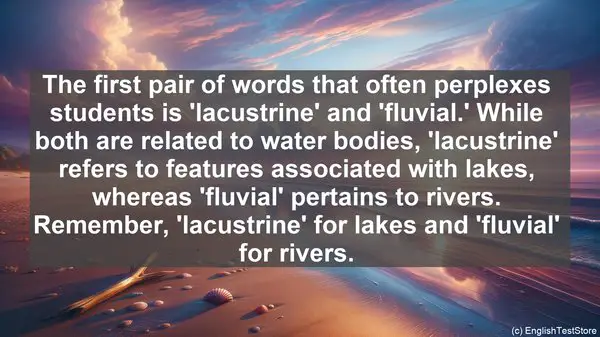Introduction
As a Limnogeology teacher, I often come across words that students find confusing. In today’s lesson, we’ll explore the top 10 commonly confused words in Limnogeology. Let’s dive in!
1. Lacustrine vs. Fluvial
The first pair of words that often perplexes students is ‘lacustrine’ and ‘fluvial.’ While both are related to water bodies, ‘lacustrine’ refers to features associated with lakes, whereas ‘fluvial’ pertains to rivers. Remember, ‘lacustrine’ for lakes and ‘fluvial’ for rivers.
2. Erosion vs. Weathering
Next up, we have ‘erosion’ and ‘weathering.’ Although both involve the breakdown of rocks, ‘erosion’ is the transportation of the weathered material, while ‘weathering’ is the actual process of rock breakdown. Think of ‘erosion’ as the movement and ‘weathering’ as the breaking.
3. Delta vs. Alluvial Fan
Moving on, ‘delta’ and ‘alluvial fan’ are often used interchangeably, but they have distinct meanings. A ‘delta’ forms at the mouth of a river, while an ‘alluvial fan’ is found in arid regions and is created by the deposition of sediment from a steep mountain front.
4. Limnology vs. Limnogeology
Now, let’s clarify the difference between ‘limnology’ and ‘limnogeology.’ ‘Limnology’ is the study of inland waters, including their physical, chemical, and biological aspects. On the other hand, ‘limnogeology’ focuses specifically on the geological aspects of these water bodies.
5. Aquifer vs. Aquitard
The terms ‘aquifer’ and ‘aquitard’ are crucial in groundwater studies. An ‘aquifer’ is a permeable rock or sediment layer that can transmit water, while an ‘aquitard’ is a less permeable layer that restricts water flow. Think of ‘aquifer’ as a water source and ‘aquitard’ as a barrier.

6. Turbidity vs. Transparency
When discussing water clarity, ‘turbidity’ and ‘transparency’ are often mentioned. ‘Turbidity’ refers to the cloudiness caused by suspended particles, while ‘transparency’ is the measure of how clear the water is. High turbidity means low transparency, and vice versa.
7. Wetland vs. Marsh
The terms ‘wetland’ and ‘marsh’ are related to areas with saturated soil. While all marshes are wetlands, not all wetlands are marshes. A ‘marsh’ is a type of wetland characterized by grasses and non-woody plants. Other wetland types include swamps and bogs.
8. Littoral vs. Pelagic
In the study of lakes, ‘littoral’ and ‘pelagic’ zones are significant. The ‘littoral’ zone is the nearshore area, where sunlight penetrates, supporting plant growth. In contrast, the ‘pelagic’ zone is the open water, away from the shore. It’s deeper and less influenced by plants.
9. Oxbow Lake vs. Meander
Two terms often encountered in river studies are ‘oxbow lake’ and ‘meander.’ An ‘oxbow lake’ is a U-shaped lake formed when a meandering river gets cut off, while a ‘meander’ is a bend or curve in the river’s course. Oxbow lakes are remnants of former meanders.

10. Groundwater vs. Surface Water
Lastly, let’s differentiate between ‘groundwater’ and ‘surface water.’ ‘Groundwater’ is water stored beneath the Earth’s surface in aquifers, while ‘surface water’ is found in lakes, rivers, and other visible bodies. Both are vital components of the hydrological cycle.
